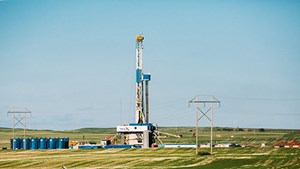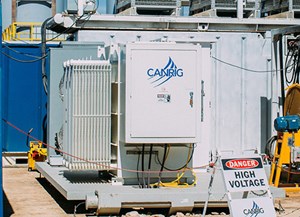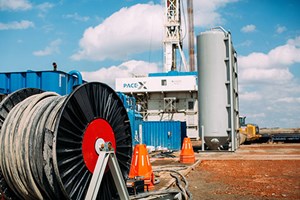The last barrel
The initiative to increase operational efficiency while reducing carbon emissions is rapidly advancing. Since 2020, our industry has done an amazing job, developing and implementing new technologies and methods to reduce GHG emissions and accelerate the drive to net-zero in a manner that also ensures an acceptable ROI and without compromising energy security. And oilfield electrification is poised to play a critical role in the transition and help define the future of offshore and onshore oil and gas production.
Electrifying U.S. shale plays. Nabors has successfully converted all four of its Hess Corporation drilling rigs working in the Bakken to highline power, Fig. 1. Nabors installed its Canrig PowerTAP highline power transformer module to enable direct power from the utility grid, Fig. 2. Backup onsite generators ensure power is uninterrupted, should an outage occur. Over the next five years, Hess expects this fully electric drilling fleet will reduce carbon emissions from its Bakken drilling operations by 50% and reduce energy costs by 70%. Powering drilling operations with electricity also reduces noise and truck traffic.


Adaptable to any rig. Hess said during the project’s pilot in 2022, the use of electricity as the primary energy source increased rig reliability by providing a secondary power source. Looking ahead, Hess expects electrification of its rigs and access to highline power also to reduce downtime. Nabors rigs have long been running on grid power. More recently, Canrig Drilling Technology, a division of Nabors, released its transformer technology. PowerTAP enables highline power utilization on any AC drilling rig where grid power is accessible, regardless of rig manufacturer. It is skid-mounted for easy transport to and from rig sites and easily installed at any location where compatible utility electrical power is available, using a standalone conductor cable reel, Fig. 3.

Case study. Field results from 20 PowerTAP modules deployed in the Lower 48 on Nabors and non-Nabors rigs indicate an initial average savings per rig of 20 metric tons of CO2 daily. Canrig also plans to introduce technologies to power additional wellsite equipment directly from the PowerTAP module and enable phase conversion capabilities where required. Canrig Senior Vice President Don Prejean commented, “we are committed to delivering responsible hydrocarbon production through smart, sustainable solutions. PowerTAP is one of many impactful technologies we’ve purpose-built to simultaneously lower costs and emissions,” Prejean concluded.
Electrifying offshore platforms. Transitioning large-scale power systems on offshore platforms to run on electricity versus diesel generators enables an infrastructure powered by low-carbon energy sources, including renewable energy, says Donald Ross, president of production systems at SLB. “All-electric production systems are a key part of a strategy to enable operators to meet sustainability goals, using integrated subsurface, subsea and surface technologies,” Ross continued.
SLB has developed a portfolio that helps minimize emissions and reduce energy consumption. It also addresses other sustainability attributes, while simultaneously driving efficiency, reliability and performance. The portfolio is divided into five subgroups that target key sustainability challenges: 1) addressing fugitive emissions; 2) minimizing drilling carbon footprint; 3) reducing or eliminating flaring; 4) full-field development solutions; and 5) electrification of infrastructure.
For offshore operations, the electrification of infrastructure and deployment of all-electric systems are enabling the industry to deliver lower-cost, lower-carbon energy. Electrification enables sustainability benefits at multiple levels, including utilization of lower-carbon energy sources, reducing operational footprint, aligning with broader platform electrification objectives and extending reservoir drainage from a single well.
By transitioning large-scale power systems used for offshore operations to run on electric power versus diesel generators, operators can power infrastructure utilizing low-carbon energy sources, including renewable power. All-electric production systems are comprised of a wide range of integrated technologies, spanning subsurface, subsea and surface environments. Electrification also accelerates digitalization, which leads to faster response times at scale, and maximizing value of remote operations.
Electrifying the subsea for a topside free environment. Baker Hughes is convinced that subsea electrification delivers on operators’ key concerns when it comes to capital, operating and carbon costs. “The time is right for this technology to enter the mainstream,” says Matt Lamb, deepwater systems product manager at Baker Hughes. However, the business case is not always clear to all operators and needs to be robustly stated. No new technology can be introduced without the necessary evidence, even when the general opinion appears to have embraced it.
“So, we undertook to investigate and thoroughly analyze the potential savings available, as well as the ways in which operations could be optimized, when using electrified control system technologies instead of a conventional, electro-hydraulic approach,” Lamb continued. We selected a site that would be a credible example of a typical subsea installation and chose SNEPCO Bonga Main field, Nigeria’s first 1,000-m, deepwater development.
The study comprised a single production loop within part of the Bonga Main field. It encompasses two production manifolds, and associated wells, control system and water-injection wells. The hypothetical project was assessed, as it would be for a new subsea electrified system, with real-world specifications and costings—and the results were conclusive.
Capex savings. Extensive analysis showed a 9% saving in subsea hardware costs at system level. Those savings come from several sources. The cost of umbilical systems were 30% lower with electric systems, while control systems were 24% lower, as was testing. The slight 1% increase in the cost of a subsea production tree system was easily offset by savings in wellhead systems, structures, distribution systems, intervention and tooling. In terms of capex, the subsea electric system easily beats traditional hydraulics.
Operational benefits. The study also indicates other areas in which the removal of high-pressure fluid systems and rotating machine parts of the hydraulic power unit can deliver notable benefits to operators. First, system availability is likely to improve, as repair demand goes down. Additionally, as hydraulic systems tend to be one of the main causes of downtime in subsea systems, the potential is there to significantly improve production availability. In addition, operators can reduce leakage pathways and marine operations—along with the risk of incorrect or faulty installation. All of which suggest reduced opex and increased production availability.

- Dallas Fed: Outlook improves, even as activity little changed; break-even prices increase (April 2024)
- Coiled tubing drilling’s role in the energy transition (March 2024)
- Advancing offshore decarbonization through electrification of FPSOs (March 2024)
- The last barrel (February 2024)
- Oil and gas in the Capitals (February 2024)
- What's new in production (February 2024)
- Applying ultra-deep LWD resistivity technology successfully in a SAGD operation (May 2019)
- Adoption of wireless intelligent completions advances (May 2019)
- Majors double down as takeaway crunch eases (April 2019)
- What’s new in well logging and formation evaluation (April 2019)
- Qualification of a 20,000-psi subsea BOP: A collaborative approach (February 2019)
- ConocoPhillips’ Greg Leveille sees rapid trajectory of technical advancement continuing (February 2019)


